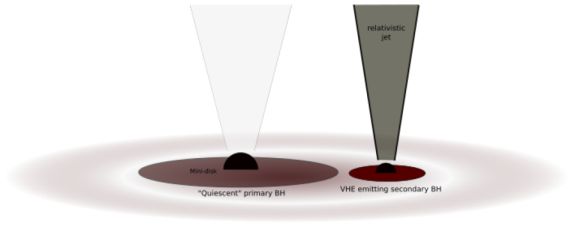


Given the above-noted VHE timing characteristics of PKS 2155-304
(log-normality and power-law noise behavior)
and the properties of disk fluctuations, one could hypothesize that the
VHE variability is driven by density fluctuations in the
accretion-disk. If these are efficiently transmitted to the jet, it
could lead to a respective, power-law noise spectrum in injection for
Fermi-type particle acceleration. One would only be able, however, to
observe rapid VHE variations (occurring on timescales as short as
Δ tobs ≃ 200 s) with the corresponding
disk characteristics if these signatures do not get obscured by other
processes occurring on longer timescale within the source. As the flux
changes seen by an observer will appear to be convolved and thus
dominated by the longest timescale, this would require that the
(observed) timescales for photons traveling across the radial width of
the source and for the relevant radiative loss processes still remain
smaller than Δ tobs. As shown in
Rieger and Volpe
(2010),
this seems feasible in the case of PKS 2155-304. To account for the
observed minimum variability, however, the
black hole mass would need to be limited to mBH
≤ 4 × 107 M⊙ (assuming
a thick inner disk); see Equation (1). In particular, the scenario would
require a black hole mass that is seemingly smaller than the
total central black hole mass inferred from the MBH
− Lbulge relation. A straightforward way to
account for this is to consider a binary black hole system where the jet
dominating VHE emission is emitted from the secondary (less
massive) black hole
(Rieger and Volpe
2010);
see Figure 11. As noted above, viewing
elliptical galaxies as a merger product of spiral galaxies, an SBBH
stage is expected to occur at some time. Once the secondary becomes
embedded in the outer disk around the primary (more massive) black hole,
it will start clearing up an annular gap. Mass supply from the
circumbinary disk to the central binary, however, can still continue
through tidal, time-dependent (periodically-modulated) gas streams,
which penetrate the gap and preferentially feed the secondary (disk) (e.g.,
Artymowicz and
Lubow 1996,
Hayasaki et
al. 2007,
Farris et
al. 2014).
Numerical simulations in particular reveal that a reversal of mass
accretion rates can occur (i.e.,
 BH,2 >
BH,2 >
 BH,1 despite
mBH,2
< mBH,1), acting towards
equal-mass binaries and suggesting that the secondary and its jet can
become more luminous than the primary. In such a scenario, a high VHE
luminosity, as inferred for PKS 2155-304, could be accounted for,
despite the smaller (secondary) black hole mass.
BH,1 despite
mBH,2
< mBH,1), acting towards
equal-mass binaries and suggesting that the secondary and its jet can
become more luminous than the primary. In such a scenario, a high VHE
luminosity, as inferred for PKS 2155-304, could be accounted for,
despite the smaller (secondary) black hole mass.
 |
Figure 11. A possible binary black hole model for PKS 2155-304, with the binary (black holes plus mini-disks) being surrounded by a circumbinary disk. The tidal gas stream from this disk preferentially feeds the less massive, secondary black hole, whose jet emission dominates the observed VHE radiation spectrum. Both the short VHE variability and the high (apparent) luminosity can thus be accommodated, cf. Rieger and Volpe (2010). |
When put in context, these considerations suggest that care needs to be exercised in the interpretation of VHE variability constraints to avoid a spurious identification of the emitting (possibly secondary) black hole mass with the total (possibly primary + secondary) central black hole mass of the system. In the case of PKS 2155-304, there are additional pieces of circumstantial evidence, such as a (comparable) small black hole mass inferred from its X-ray variability (PSD) properties (e.g., Czerny et al. 2001), indications for optical long-term (∼7 y) periodicity (Fan and Lin 2000), and jet bending on pc-scales (e.g., Piner et al. 2010), which may in fact be more easily integrated within a binary framework.